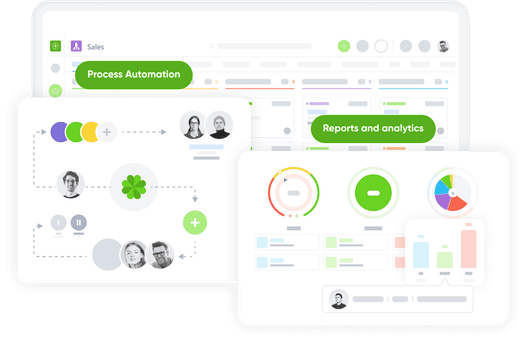Empowering Team Synergy with Innovative Activities in 2024
The scenario is all too familiar: the collective groan that echoes through the office as a team-building exercise is announced.

But why the collective dread?
Typically, it's because these well-intentioned activities tend to feel contrived and uncomfortable, despite the organizer's best efforts and enthusiasm.
The good news?
There's a formula for crafting team-building activities that genuinely enhance engagement and cultivate a dynamic, cohesive team. The secret lies in moving beyond the beaten “balloon pass” and embracing fresh, innovative approaches.
Fear not; we've already brainstormed for you.
In this comprehensive guide, we'll delve into the essence of team building and explore 34 cutting-edge activities designed to galvanize your team.
Ready to dive in?
34 Cutting-Edge Team Building Activities
We begin with five icebreaker activities perfect for teams still on the cusp of forming bonds.
As your team gears up to step out of their comfort zones, we offer detailed instructions for 24 team-building exercises that promise to be as enjoyable as they are enlightening.
And for teams that span continents, we've included five innovative virtual team-building activities that bridge the gap between time zones and physical distance.
Our curated selection includes both indoor and outdoor activities, crafted to enhance employee engagement across the board.
Whether you're coordinating a small team or a larger group, these games are scalable and adaptable to your needs.
Regarding Group Sizes
Each activity specifies a 'group size.' This isn't the headcount for the entire team-building session but rather the recommended number for each subgroup within the larger assembly. For instance, a group of 20 can be divided into smaller teams of 4 or 5.
This is a common practice in corporate training programs, allowing for simultaneous participation in various activities.
5 Icebreaker Games
Icebreakers are brief, informal games that lay the groundwork for camaraderie, paving the way for more
These games are invaluable for both
1. Two Truths and a Lie
Duration: 15–30 minutes
Ideal Group Size: 4–6
Goal: Foster camaraderie
Participants play detective in this game, sifting through truths and fabrications to learn about each other.
Each person shares two truths and one lie in no particular order. Teammates then guess which statement is the lie, leading to surprising revelations and laughter.
2. What’s My Name
Duration: 15–20 minutes
Ideal Group Size: Up to 20
Goal: Build rapport
Gather your team in a circle. Each person introduces themselves before tossing a tennis ball to another team member, calling out their name.
To add a twist, implement a rule where the ball cannot be passed to the same person consecutively.
3. Crafting a Narrative
Duration: 30 minutes
Ideal Group Size: Flexible
Goal: Enhance listening, collaboration, and teamwork
In this creative exercise, team members form a circle. One person begins a story but pauses mid-sentence. The next person completes the sentence and adds another, leaving it open-ended.
This continues until a complete, coherent narrative is woven, emphasizing the importance of attentive listening—a key ingredient in the recipe for business success.
For an added layer of complexity and creativity, integrate random words that must be included in the story, challenging the team to think on their feet.
Revolutionizing Team Dynamics with Engaging Activities
Let's delve into more innovative activities designed to enhance communication, trust, and problem-solving within your team.
4. Silent Strategy
Duration: 20 minutes
Ideal Group Size: Up to 20
Goals: Non-verbal communication, collaboration
Challenge your team to arrange themselves according to a specific criterion—like age or height—without speaking. This silent exercise not only ignites creative non-verbal strategies but also underscores the emergence of leaders and the significance of body language.
5. Personal Showcase
Duration: 30–60 minutes
Ideal Group Size: 10–15
Goals: Trust-building
Especially effective for remote teams, this activity encourages participants to share a personal item they hold dear. It could be anything from a cherished pet to a favorite book. This practice not only fosters trust through personal storytelling but also solidifies team connections.
24 Team Building Activities for a Cohesive Squad
Now, let's explore 24 team-building exercises designed to foster rapport, trust, and collaborative problem-solving.
6. Life's Highlights
Duration: 30–45 minutes
Ideal Group Size: 15–20
Goals: Rapport, trust
Prompt your team members to reflect on the most cherished moments of their lives and share the 30 seconds they would choose to relive if possible. This profound sharing activity is an effective way to dismantle barriers and forge meaningful connections.
7. Survival Scenario
Duration: 30 minutes
Ideal Group Size: 4–6
Goals: Problem-solving, teamwork, creativity
Place your team in a survival scenario, such as being marooned on a deserted island. They must select essential items from a provided list to 'survive.' This exercise not only stimulates creativity but also demands strategic thinking and teamwork.
8. The Innovation Game
Duration: 10 minutes
Ideal Group Size: 4–6
Goals: Problem-solving, communication, creativity
Distribute everyday objects to small groups and challenge them to demonstrate inventive uses for these items, with others guessing the intended use. This game is a delightful way to encourage innovative thinking and effective communication.
Cultivating Team Unity Through Creative Challenges
Continuing with our suite of innovative team-building exercises, we present more activities designed to foster rapport, challenge biases, and enhance problem-solving skills.
9. Unearthing Common Ground
Duration: 5 minutes
Ideal Group Size: 4–6
Goals: Rapport building, bias awareness
Encourage groups to swiftly identify a common interest or characteristic. For example, they might all enjoy hiking. During the session, they'll use hiker jargon, employing terms like “trailblazing” or “summit.” This playful roleplay leads to discussions about the absurdity of stereotypes and prompts members to share unique aspects of themselves, thereby breaking down preconceptions.
10. Collaborative Mosaic
Duration: 20 minutes
Ideal Group Size: 8
Goals: Teamwork, big-picture thinking
Give each team member a segment of a picture to recreate on a larger scale. When combined, these individual pieces unveil a complete image, illustrating each person's contribution to the team's success. The metaphor here is both intentional and enlightening.
11. Crisis Simulation
Duration: 45–60 minutes
Ideal Group Size: 4–6
Goals: Strategic planning, problem-solving
Concoct a hypothetical crisis pertinent to your team's domain. For a marketing team, envision a campaign that has backfired. Assign the group to formulate a recovery strategy, including a public apology and forward-looking tactics. This proactive drill equips the team for potential real-life challenges and aids in establishing contingency plans.
12. Urban Adventure
Duration: Over 60 minutes
Ideal Group Size: 4–6
Goals: Team bonding, problem-solving
Plan a scavenger hunt, either outside or within the office premises. In a city like Chicago, a clue might direct participants to the famed Cloud Gate sculpture. Teams must decipher clues and document their journey, promoting collaboration and a spirit of adventure.
13. Pencil Drop
Duration: 20 minutes
Ideal Group Size: Pairs
Goals: Cooperation, precision
Match team members into pairs and challenge them to lower a pencil into a bottle using strings tied to both the pencil and themselves. This task demands patience, coordination, and collective effort, as they must act in harmony to succeed.
14. The Human Knot
Duration: 20 minutes
Ideal Group Size: 8–15
Goals: Team unity, communication
Instruct the team to form a circle and grasp hands with colleagues across from them, creating a human knot. Their objective is to disentangle themselves without releasing their grip. This activity serves as a tangible metaphor for problem-solving and hinges on effective communication and joint effort.
Fostering Future-Focused Team Synergy
Let's continue with the next set of team-building exercises, each designed to enhance vision-building, communication, and trust within your team.
15. Visionary Headlines
Duration: 10 minutes
Ideal Group Size: 4–6
Goals: Vision building, collaboration
Provide newspapers to small groups and instruct them to create 10 fictional headlines that envision the company's future. Sharing these headlines aloud aids in aligning team members with the organization's long-term goals and uncovers various perspectives on future growth.
16. Celebrity Identity
Duration: 15 minutes
Ideal Group Size: 5–10
Goals: Deductive reasoning, communication
Employ
17. Arctic Shelter Challenge
Duration: 30–60 minutes
Ideal Group Size: 4–6
Goals: Leadership, trust, problem-solving
Imagine teams are stranded in the Arctic. The 'leader' has frostbite in their hands, while the rest are 'blindfolded' by a snowstorm. The leader must guide their team to construct a shelter using only verbal instructions, enhancing trust and communication.
18. Bound Together
Duration: 10 minutes
Ideal Group Size: 2–4
Goals: Teamwork, creative problem-solving
Bind team members' hands together and challenge them to complete tasks, such as board games or puzzles. This activity necessitates creative thinking and close cooperation to achieve common goals while physically connected.
19. Blind Artistry
Duration: 10–15 minutes
Ideal Group Size: Pairs
Goals: Trust, detailed communication
Pair up team members to sit back-to-back. One holds an object or picture, while the other has paper and pencil. The holder describes the item without naming it, allowing the other to draw it, emphasizing the importance of clear communication and trust in the partner's instructions.
20. Uncommon Connections
Duration: 10 minutes
Ideal Group Size: 4–6
Goals: Creative thinking, collaboration
Present teams with a series of random objects and ask them to categorize them. This exercise encourages creative thinking and demonstrates how diverse elements (or team members) can be connected in unexpected ways.
Enhancing Team Dynamics with Strategic Play
Let's delve into the next set of team-building exercises, each crafted to bolster trust, enhance communication, and hone problem-solving skills within a collaborative framework.
21. Toxic River Challenge
Duration: 15–30 minutes
Ideal Group Size: 10–20
Goals: Teamwork, strategic communication, trust
Transform an area into a 'toxic river' and provide teams with limited resources, such as cardboard squares, to traverse it without 'falling' into the hazardous area. This challenge underscores the necessity of strategic planning and mutual support in high-pressure situations.
22. Dream Getaway Sharing
Duration: 10–20 minutes
Ideal Group Size: Pairs
Goals: Active listening
Have team members pair up and describe their ideal vacation to each other. Afterwards, each person must recount their partner's dream holiday, testing their listening skills and capacity for detail, while also fostering a deeper interpersonal connection.
23. Sculpture Replication
Duration: 30 minutes
Ideal Group Size: 4–6
Goals: Memory, communication, teamwork
Construct a sculpture hidden from the team's view. Allow team leaders brief glimpses to memorize the structure and then instruct their teams to replicate it. This exercise assesses memory retention, communication skills, and the ability to guide execution based on a shared vision.
24. Electric Fence Navigation
Duration: 20 minutes
Ideal Group Size: 10–15
Goals: Trust, cooperation, creative problem-solving
Erect an 'electric fence' and challenge teams to cross it without making contact, all while remaining in physical touch with a teammate. This task demands inventive solutions, a high degree of trust, and collaborative effort.
25. Jigsaw Diplomacy
Duration: 30 minutes
Ideal Group Size: 8–20
Goals: Collaboration, negotiation, strategic communication
Split participants into teams to assemble jigsaw puzzles with intermingled pieces. Teams must engage in negotiations to exchange the correct pieces, one by one, encouraging patience, articulate communication, and joint problem-solving. To intensify the challenge, place the teams in separate rooms to mimic remote communication barriers.
Building Synergy with Engaging Team Initiatives
Let's delve into the next set of team-building exercises, each crafted to foster innovation, enhance communication, and encourage a collaborative spirit.
26. Bridge Construction Collaboration
Duration: 60 minutes
Ideal Group Size: 8–20
Goals: Innovation, teamwork, engineering skills
In this activity, teams work on constructing two halves of a bridge with a variety of materials. They must plan and execute their designs separately, then come together to unite their creations into a single structure, mirroring the need for alignment in workplace projects.
27. Crafting a Code of Conduct
Duration: 30+ minutes
Ideal Group Size: 10–30
Goals: Value alignment, trust-building
This exercise involves creating a group code of conduct for workshops or ongoing team interaction. Team members contribute ideas to a mind map, fostering a shared understanding of group values and expectations, which is crucial for a harmonious work environment.
28. The Marshmallow Challenge
Duration: 18–30 minutes
Ideal Group Size: 2–40+
Goals: Creative problem-solving, risk management
Teams are given spaghetti sticks, tape, string, and a marshmallow, with the task to build the tallest structure that can support the marshmallow at the top. This challenge encourages creative thinking and practical problem-solving, with a fun twist.
29. Company Excursion
Duration: Over 60 minutes
Ideal Group Size: Entire team
Goals: Cross-departmental bonding, informal communication
The most lavish of team-building events, a company outing to an activity like a cooking class or a golf day, can significantly boost morale and rapport. It's an opportunity for employees from different departments to interact in a non-work setting, fostering natural connections and team cohesion.
Fostering Remote Team Unity with Virtual Team Building
Here's a look at some engaging virtual team-building activities designed to bridge the gap between remote workers and create a sense of closeness and camaraderie.
30. Online Game Show Extravaganza
Duration: 60 minutes
Ideal Group Size: 4–500
Goals: Team engagement, quick thinking, collaboration
Transform your team meeting into a virtual game show, complete with a host and a variety of classic game segments. This activity brings the thrill of a game show to your remote team, encouraging participation and teamwork in a lively, competitive environment.
31. Digital Happy Hour
Duration: 60 minutes+
Ideal Group Size: Entire team
Goals: Social bonding, informal interaction
Host a virtual happy hour to unwind and connect on a personal level. Incorporate light-hearted games and activities to facilitate bonding and provide a space for team members to interact outside of work-related tasks.
32. Remote Pictionary Challenge
Duration: 30 minutes
Ideal Group Size: 6+
Goals: Creativity, team spirit
Using a digital whiteboard, teams compete in a classic game of Pictionary. This game encourages creative expression and teamwork, and it's a great way for even the quieter team members to get involved and have fun.
33. Home Tours
Duration: 20–30 minutes
Ideal Group Size: 4+
Goals: Personal connection, team intimacy
Invite your team for a virtual tour of each other's homes. Whether live or through pre-recorded videos, this activity offers a personal glimpse into the lives of team members, fostering deeper connections and understanding.
34. Virtual Escape Room Challenge Duration: 60 minutes Ideal Group Size: 4+ Goals: Problem-solving, teamwork, creative thinking
Engage your remote team in a virtual escape room experience. This activity requires collaboration, communication, and collective problem-solving as team members guide a game host through a series of puzzles and challenges to 'escape' the virtual room.
10 Key Advantages of Team Building Initiatives
Unified Vision: Team building helps communicate a shared vision across the team, often facilitated by team communication apps.
Positive Culture: Activities can foster a more enjoyable and effective company culture.
Interdepartmental Synergy: They bridge gaps between different departments, promoting a more cohesive organization.
Behavioral Management: Team building can prevent dysfunctional behaviors by fostering bonding and communication.
Collaborative Decisions: Such activities improve collaborative decision-making abilities within teams.
Trust and Familiarity: They nurture trust, familiarity, and mutual understanding among team members.
Engagement and HR Goals: These activities can boost employee engagement, aiding in the achievement of HR objectives.
Skill Enhancement: They enhance communication, leadership skills, and team dynamics.
Company Pride and Motivation: Team building promotes healthy company pride, playful competition, and motivation.
Valued Employees: They help employees feel valued and recognized within the company.
Embracing Team Building for Success
Incorporating team building activities like the egg drop, barter puzzle, company treasure hunts, and office trivia can significantly boost morale and foster strong bonds among team members. Celebrating these moments with a memory wall can serve as a constant reminder of the team's journey and achievements, further enhancing the company culture. For more

Emily Johnson
Share





